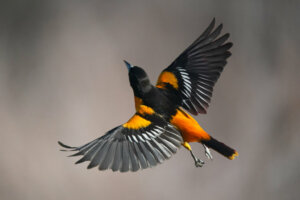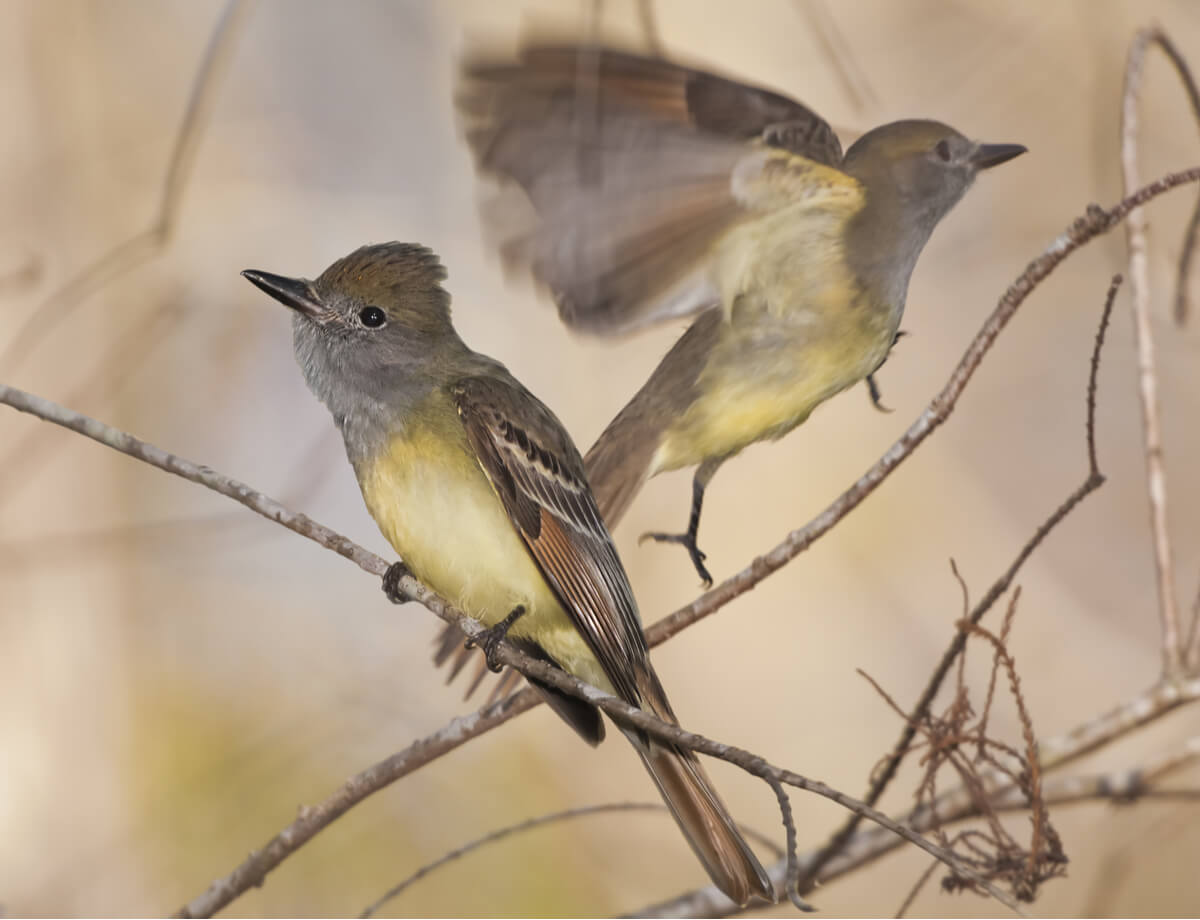Find Out How Birds Fly!

To soar through the skies has been a human dream almost since the dawn of time. Wondering how birds fly has led to great inventions, which now make our lives so much easier. However, a person has still never managed to fly like a bird does.
What’s their secret? Clearly, something differentiates flying birds from other animals and allows them to stay airborne. Learn how birds fly in this article!
What does it take to fly?
The most obvious answer to this question is the presence of wings and feathers on these animals’ bodies, but they alone don’t explain the ability to fly. The following anatomical adaptations will help you understand why and how birds fly.
Weight reduction
There are 2 key factors when it comes to body modifications: air sacs and skeletal pneumaticity. The former are cavities within the body of the bird that are filled with air when it breathes, giving it lightness. Air also circulates inside their bones to make them less heavy – that’s why they’re called pneumatized, as they’re hollow.
Birds have also lost body parts throughout evolution in order to reduce their weight, such as teeth and noses. They don’t have a bladder and, in addition, they develop reproductive organs only during the mating season. If they aren’t going to use them apart from in the spring, why carry them all year long? Not sure that would work with humans!
Most female birds only develop one ovary, to further minimize their overall weight.

Muscle and bone modifications
Birds’ center of gravity has shifted towards the point between the two wings and the head. By concentrating all the weight on one part of the body, they can lift their weight more efficiently.
To achieve the latter, they have bone and muscular modifications, so that their largest and strongest muscles are the breasts, which are in charge of flapping their wings. The breasts are anchored to the sternum thanks to the bony ridge that has developed – the keel. Scapulae, clavicles and coracoids have also been modified to favor the flapping of the wings.
Their respiratory system also answers how and why birds fly
Birds’ lungs are small and flat, as air circulates throughout their bodies through air sacs and hollow bones. Despite this, they’re incredibly efficient, as these animals need oxygen to be delivered through the body at high speed while flapping their wings. Flying requires enormous energy expenditure.
Why and how do birds fly?
You might be wondering what wings and feathers have to do with the equation after all this. Well, if the body has been modified to be able to soar, then wings and feathers are the final piece of the puzzle that birds need in order to take off. Thanks to them, the bird manages to overcome gravity, as they allow it to control the air currents to separate itself from the ground.
When taking off, the shape of the wings allows propulsion, through the air that’s fanned towards the ground. Once in flight, the bird only has to adjust the position of the wings to glide or keep flapping them to continue soaring. This couldn’t work if the feathers didn’t offer air resistance.
Imagine that you have a pen in your hand. If you shake it on its flat part, you’ll move the air, as if you were fanning yourself. But if you cut the air with its edge, the air hardly flinches.
The movement of the wings, when observed in slow motion, is similar to rowing or swimming. For this reason, birds don’t flap their wings up and down, because that way they couldn’t create a current under their body that keeps them in the air.

Birds, these wonderful creatures made of air and music, will continue to fill the human imagination for many years to come. What for them is survival and natural selection, is, for us, one of our most unattainable dreams. Let’s work together to ensure that birds continue to soar through the skies for many millennia to come.
To soar through the skies has been a human dream almost since the dawn of time. Wondering how birds fly has led to great inventions, which now make our lives so much easier. However, a person has still never managed to fly like a bird does.
What’s their secret? Clearly, something differentiates flying birds from other animals and allows them to stay airborne. Learn how birds fly in this article!
What does it take to fly?
The most obvious answer to this question is the presence of wings and feathers on these animals’ bodies, but they alone don’t explain the ability to fly. The following anatomical adaptations will help you understand why and how birds fly.
Weight reduction
There are 2 key factors when it comes to body modifications: air sacs and skeletal pneumaticity. The former are cavities within the body of the bird that are filled with air when it breathes, giving it lightness. Air also circulates inside their bones to make them less heavy – that’s why they’re called pneumatized, as they’re hollow.
Birds have also lost body parts throughout evolution in order to reduce their weight, such as teeth and noses. They don’t have a bladder and, in addition, they develop reproductive organs only during the mating season. If they aren’t going to use them apart from in the spring, why carry them all year long? Not sure that would work with humans!
Most female birds only develop one ovary, to further minimize their overall weight.

Muscle and bone modifications
Birds’ center of gravity has shifted towards the point between the two wings and the head. By concentrating all the weight on one part of the body, they can lift their weight more efficiently.
To achieve the latter, they have bone and muscular modifications, so that their largest and strongest muscles are the breasts, which are in charge of flapping their wings. The breasts are anchored to the sternum thanks to the bony ridge that has developed – the keel. Scapulae, clavicles and coracoids have also been modified to favor the flapping of the wings.
Their respiratory system also answers how and why birds fly
Birds’ lungs are small and flat, as air circulates throughout their bodies through air sacs and hollow bones. Despite this, they’re incredibly efficient, as these animals need oxygen to be delivered through the body at high speed while flapping their wings. Flying requires enormous energy expenditure.
Why and how do birds fly?
You might be wondering what wings and feathers have to do with the equation after all this. Well, if the body has been modified to be able to soar, then wings and feathers are the final piece of the puzzle that birds need in order to take off. Thanks to them, the bird manages to overcome gravity, as they allow it to control the air currents to separate itself from the ground.
When taking off, the shape of the wings allows propulsion, through the air that’s fanned towards the ground. Once in flight, the bird only has to adjust the position of the wings to glide or keep flapping them to continue soaring. This couldn’t work if the feathers didn’t offer air resistance.
Imagine that you have a pen in your hand. If you shake it on its flat part, you’ll move the air, as if you were fanning yourself. But if you cut the air with its edge, the air hardly flinches.
The movement of the wings, when observed in slow motion, is similar to rowing or swimming. For this reason, birds don’t flap their wings up and down, because that way they couldn’t create a current under their body that keeps them in the air.

Birds, these wonderful creatures made of air and music, will continue to fill the human imagination for many years to come. What for them is survival and natural selection, is, for us, one of our most unattainable dreams. Let’s work together to ensure that birds continue to soar through the skies for many millennia to come.
All cited sources were thoroughly reviewed by our team to ensure their quality, reliability, currency, and validity. The bibliography of this article was considered reliable and of academic or scientific accuracy.
- ¿Por qué vuelan las aves? (2016, 1 abril). SEO Birdlife. https://seo.org/2016/04/01/vuelan-las-aves/
- Cano, F. G. (2010). Anatomía específica de aves: aspectos funcionales y clínicos. Facultad de veterinaria, Universidad de Murcia,[En línea]. Available: https://www. um. es/anatvet/interactividad/aaves/anatomia-aves-10. pdf.
- Cruz, J. (1989). Fijación externa del húmero en aves rapaces. Dipòsit Digital de Documents de la UAB. https://ddd.uab.cat/record/69558
- Manzanares, M. A. (2007). Adaptaciones musculares relacionadas a áreas corporales que participan activamente en el vuelo de Anhima cornuta (Aves: Anseriformes, Anhimidae). Revista Peruana de Biología. http://www.scielo.org.pe/scielo.php?script=sci_arttext&pid=S1727-99332007000200025
This text is provided for informational purposes only and does not replace consultation with a professional. If in doubt, consult your specialist.








